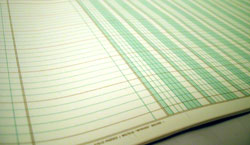 Tracking Your Income and Expenses
Tracking Your Income and Expenses
To make your budget fully effective, you have to stick to it. Here, we’re going to show you how to track your expenses to make sure you stick to your budget, don’t overdraw your accounts, and can see what your actual income and expenses are.
If you have an online banking account, you can refer to it to keep track of what you are spending and how much money you have left to spend. Verify that the charges and payments listed are correct. Save your receipts and compare them to what’s listed on your online or physical bank statement.
Below are some additional ways to track your expenses:
1.Track your expenses using a General Ledger.
A general ledger is an income and spending journal, where you record your earning and spending. Your general ledger also helps you keep track of how much money you have to spend so you don’t overspend or “bounce” a check (overdraw your account).
For this system to work, it is important to not forget your expenses, meaning you’ll have to record all your expenses. Get receipts for any purchases you make and devote a daily or weekly time that you will go through your receipts and enter them into your general ledger.
Cross-check this with your bank statement to make sure you are on the same page. This is called reconciling your account, and helps you make sure you know how much money you have to spend. It also helps you verify that you aren’t being overcharged, which is another good reason to keep your receipts. This will also help you catch any expenses you forgot to list on your general ledger. It will take some time for your expenses to show up on either your online or your mailed statement after you spend the money, so don’t assume you have the total amount listed in your balance to spend. If you spend thinking you have extra money and then the transaction shows up, you may spend more than what is in your account. This is called overdrawing your account and you can get a wasteful “non-sufficient funds” fee.
You also record income you have to spend in your general ledger. Instead of recording it as an expense “-$10 Movie tickets”, you record it as income “+100 gift from Uncle Ron.” Of course, you would add to the amount you have in your account balance/money to spend, unlike an expense, where you subtract the amount.
You’ll eventually want to compare your general ledger and/or online bank account to your budget to see if you stuck to your spending plan.
See How to Create a General Ledger for further instructions, or download our General Ledger template here.
Track a specific expense category using a Specific Ledger. A specific ledger can be used on a particular expense category that’s giving you trouble, such as dinners out, or shopping, or music. For example, let’s say “dinners out” are a problem category for you because you’re having trouble controlling spending in that category. Create a specific ledger for that category. And set a limit for that category and every time you dine out, record it in your dining out specific ledger. When the number left is zero, you’ve spent your limit and it’s time to eat at home. The envelope method is an old-fashioned but very useful physical version of the Specific Ledger. Let’s say you are having trouble with a budget category, for example “shopping.” You set a limit for that category, say $75. You get an envelope and put “shopping” on the envelope. Put $75 into the envelope. Every time you go shopping, take money from the envelope. When there is nothing left in the envelope, your spending in that category needs to stop. This is one main thing budgets are for–to make sure you stop spending when you need to–and you need to track your spending to make this work.
See How to Create a Specific Ledger for further instructions, or download our Specific Ledger template here.